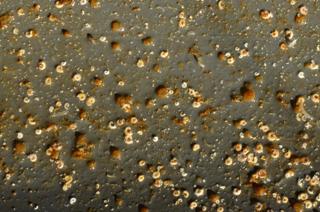Jan 29 2015
A new study of marine organisms that make up the 'biofouling community' - tiny creatures that attach themselves to ships' hulls and rocks in the ocean around the world - shows how they adapt to changing ocean acidification. Reporting in the journal Global Change Biology, the authors examine how these communities may respond to future change.
 A close up of the pipe shows Spirobid worms and sponges used in the experiment. Credit: Deborah Power
A close up of the pipe shows Spirobid worms and sponges used in the experiment. Credit: Deborah Power
There is overwhelming evidence to suggest the world's oceans are becoming, and will continue to become more acidic in the future, but there are many questions about how it will affect marine life. The 'biofouling community' - consisting of tiny species like sea squirts, hard shell worms and sponges - affects many industries including underwater construction, desalination plants and ship hulls. Removing these organisms (a process called antifouling) is estimated to cost around $22 billion a year globally.
For the first experiment of its kind, over 10,000 animals from the highly productive Ria Formosa Lagoon system in Algarve, Portugal were allowed to colonise hard surfaces in six aquarium tanks. In half the tanks, the seawater had the normal acidity for the lagoon (PH 7.9) and the other half were set at an increased acidity of PH 7.7. The conditions represented the IPCC's prediction for ocean acidification over the next 50 years.
After 100 days, animals with hard shells (Spirobid worms - Neodexiospira pseudocorugata) reduced to only one fifth of their original numbers, while sponges and some sea squirts (Ascidian Molgula sp) increased in number by double or even fourfold.
Lead author Professor Lloyd Peck from British Antarctic Survey (BAS) says:
"Our experiment shows the response of one 'biofouling community' to a very rapid change in acidity, but nonetheless shows the degree to which these communities could be impacted by ocean acidification, and to which its associated industries may need to respond. What's interesting is that the increased acidity at the levels we studied destroys not the building blocks in the outer shell of the worms itself, but the binding that holds it together. Many individuals perish, but we also showed their larvae and juveniles are also unable to establish and create their hard exoskeleton."
Professor Peck continues, "Although a PH reduction of 0.2 is less than the IPCC's 'business as usual' scenario of PH 0.3 - 0.4 in ocean surface waters by 2100, it will likely be achieved between 2055 and 2070."
Author, Dr. Deborah Power, from Centro de Ciências do Mar says: "Taking into consideration the importance of the Ria Formosa lagoon as a natural park the modified community structure driven by a reduction in PH, while potentially reducing biofouling issues, will almost certainly affect lagoon productivity and impact on biodiversity."